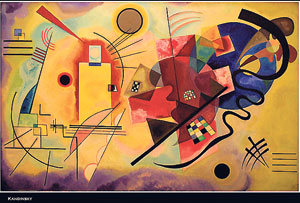A visual art programme devoted to the father of abstract art, Vassily Kandinsky is now on at the Alliance française de Kandy. The exhibition depicting the life and the main works of this artist continues till November 2.
Meanwhile 25 art students from ten schools in Kandy and Kegalle attending an art workshop this weekend at the Alliance will have their works exhibited from October 28 till November 2.
Born on December 4, 1866 in Moscow, just 15 years before the birth of Pablo Picasso, Vassily Kandinsky’s childhood ambition was to be a musician. Studying law and economics at the Moscow University he took a keen interest in ancient art and folk-art of Russia. This interest kindled his artistic awakening.
During this period he saw the work of old masters in Moscow, St. Petersburg and Paris. After viewing in Moscow an exhibition by the French Impressionists in 1896 and seeing a painting by Monet (Haystacks), he bade goodbye to his legal career and proceeded to Munich to study painting.
After entering the Royal Academy of Munich, he devoted the rest of his life to art. For 12 long years he travelled extensively in Paris, Tunisia, Italy, Berlin and Munich gaining considerable knowledge in painting.
He came into contact with Cézanne and the Fauves and built up a close relationship with them. The various influences which dominated his artistic vision up to this period gradually diminished and finally he was liberated from them all.
In 1910, Kandinsky wrote a historic treatise, considered as the first justification of a non-objective art. Its originality and prophetic vision was appreciated by art lovers during this period. It earned a widespread reputation as the birth of a new artistic faith in the world of art.
Kandinsky remained in Russia until 1921, devoting his entire time and energy to the reorganization of the Academy of Fine Arts, the art schools, and museums. At the end of the year he left for Berlin, and Walter Gropius invited him to assist in the formation of the School of Design at Weimar. His second treatise ‘Point and Line to Plane’ was published in Munich in 1926.
In 1924 Kandinsky formed a group with Paul Klee, Feininger and Jawlensky, which was named ‘Die Blaue Vier’ (The Blue Four). Their work was exhibited in Dresden and Wiesbaden. However, Kandinsky opted to exhibit alone. After the Nazi government closed down the Bauhaus in 1932, he became a French citizen in 1939 and remained in Paris until his death in 1944.
Combining Impressionism and Fauvism, Kandinsky attained aesthetic maturity with a style which is highly original. Today he is seen as one of the most influential artists of his generation. |


